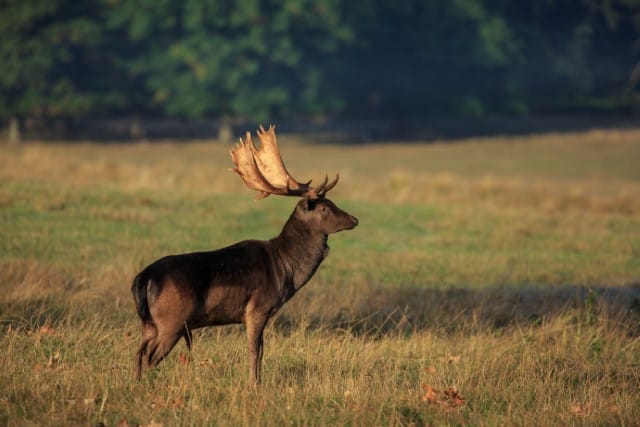You’ve probably never seen one yourself, but maybe you have heard legends about white deer. Is the white deer an albino deer? In most cases, the answer is no. White deer are usually leucistic deer. Keep reading to discover fundamental facts about leucism in deer.
Let’s learn everything you need to know about leucistic deer, so you can understand the differences between these white deer and other types of deer, including those which are true albinos.
What is a Leucistic Deer?
Leucistic deer are not a separate species of deer. Any type of deer can be leucistic. A genetic mutation that causes a lack of pigment production causes leucism. This is different from albinism, which we’ll get to in a minute.
Other kinds of animals, such as squirrels, cats, and horses, can also be leucistic.

Most leucistic animals have only partial leucism. This means that only parts of their skin or fur lack pigmentation.
For example, a partially leucistic deer may have white spots on an otherwise normal coat.
Completely white deer with leucism are rarer. These animals have completely white coats, but they aren’t albino animals.
Leucistic vs Albino Deer
By contrast to leucistic deer, albino deer don’t have any melanin. Melanin is a pigment that gives skin or fur a darker color.
This is why albino animals are always completely white. In albinism, there is no melanin, but there can be other pigmentation.
Both leucism and albinism are genetic mutations. Unlike leucism, which can occur partially, animals cannot be partially albino.

An animal is either albino or not. A major difference between even completely leucistic and albino deer is in eye color.
Albino deer may have pink or even red eyes because of their unusual pigments. These deer often also have impaired eyesight.
Deer with leucism, on the other hand, have brown eyes.
Albino animals don’t have any melanin but they do have other pigments. This is why albino animals may sometimes have a yellowish color.
When it comes to a white deer, you can probably tell whether it’s albino or just has leucism by looking at its eyes.
How Common Is Leucism in Deer?
Leucistic deer are rare. A recessive gene causes the leucism trait.
Leucistic animals have difficulty surviving in the wild because they don’t blend in with the environment. It may become more common in an inbred population.
One area of the United States, however, seems to have a fairly high leucistic cervid population. This is Seneca Falls, New York, and we will talk about that later.
White-tailed deer are the most commonly found deer in North America. Thus, it is not surprising that the most documented deer with leucism have been white-tailed deer.
Leucism has also been seen in fallow deer.
History of Seneca Falls Deer
During the 1940s, a military base was established in Seneca Falls and it is suspected that several leucistic white-tailed members of a herd became trapped in the base. This led to intense inbreeding.
As the base was closed off from the outside world, the deer stayed safe from predators. And even when the base began to allow hunting, they forbade the hunting of white deer.
These factors led to an explosion in the deer population with leucism.
The old military base area is now called Seneca Falls Depot. Experts believe the Seneca White Deer herd still has the world’s highest rate of leucism in deer. It may even have the highest rate of leucism in any animal.
However, leucistic deer are now a minority in relation to the rest of the area’s population.
Leucistic vs Piebald
Some people mistakenly refer to piebald deer as partially albino deer. In reality, they’re partially leucistic.
This means that in some areas of the deer’s fur, there is simply no pigmentation. Those areas of the coat are white.

Piebaldism is more common than full leucism and much more common than albinism.
A piebald deer is recognizable because splotches of its fur are white. The coat is not entirely white like a fully leucistic (or albino) deer.

Piebaldism can occur in other animals, too. Some domestic cats are bred specifically to preserve piebaldism.
Leucistic vs Melanistic Deer
Melanistic deer are the visual opposite of leucistic deer. They have a genetic mutation that makes their entire coat dark because of the pigment melanin.

Melanistic deer are another type of extremely rare deer. We recognize them by their dark, almost black coats
Like leucism and albinism, a genetic mutation causes melanism. Experts believe that melanism is the rarest of these traits.
Melanism can occur in other animals as well. The black panther is the most common example. Black panthers are actually just leopards or jaguars with melanism.

As a recessive trait, melanism is more likely to occur when deer populations have high rates of inbreeding.
Can You Hunt Leucistic Deer?
Some areas have local regulations on hunting unique deer with leucism or those that are piebald, so you should check those before you go hunting.
Most hunters probably wouldn’t hunt a leucistic deer to preserve its uniqueness. Many Native American cultures prize the leucistic deer and consider it forbidden to hunt due to the symbolism of white deer.
Some hunters have superstitious beliefs about killing white deer. For example, they think that if you kill a white deer you will never be able to find another deer.
The reality is that the only thing that makes white deer with leucism different from other deer is their leucism.
Wrapping Things Up: Leucistic Deer
We have learned all the most fundamental facts about these unique white deer. Let’s do a quick review of them below.
- Leucistic deer are white because of leucism (a genetic mutation).
- Leucistic deer aren’t a separate species.
- Leucism occurs in many other animals.
- Leucism and albinism are two different traits.
- A deer may be fully leucistic (completely white) or partially leucistic (piebald).


